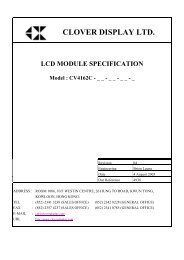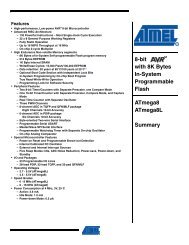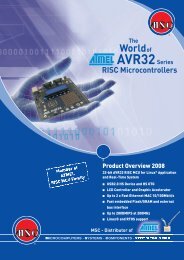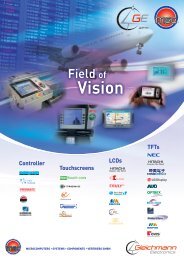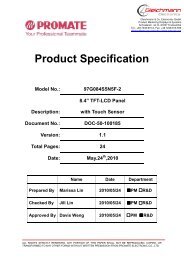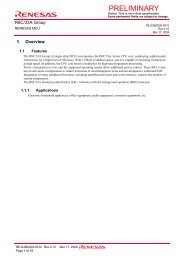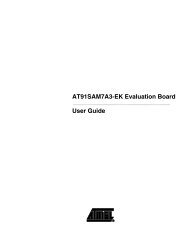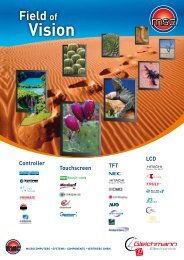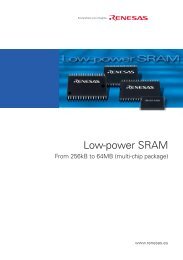SL811HS Embedded USB Host/Slave Controller
SL811HS Embedded USB Host/Slave Controller
SL811HS Embedded USB Host/Slave Controller
Create successful ePaper yourself
Turn your PDF publications into a flip-book with our unique Google optimized e-Paper software.
<strong>SL811HS</strong><br />
Interrupt Enable Register [Address = 06h]. The <strong>SL811HS</strong><br />
provides an Interrupt Request Output, which is activated for a<br />
number of conditions. The Interrupt Enable register allows the<br />
user to select conditions that result in an interrupt that is issued<br />
to an external CPU through the INTRQ pin. A separate<br />
Interrupt Status register reflects the reason for the interrupt.<br />
Enabling or disabling these interrupts does not have an effect<br />
on whether or not the corresponding bit in the Interrupt Status<br />
register is set or cleared; it only determines if the interrupt is<br />
routed to the INTRQ pin. The Interrupt Status register is<br />
normally used in conjunction with the Interrupt Enable register<br />
and can be polled in order to determine the conditions that<br />
initiated the interrupt (See the description for the Interrupt<br />
Status Register). When a bit is set to ’1’ the corresponding<br />
interrupt is enabled. So when the enabled interrupt occurs, the<br />
INTRQ pin is asserted. The INTRQ pin is a level interrupt,<br />
meaning it is not deasserted until all enabled interrupts are<br />
cleared.<br />
Table 13. Interrupt Enable Register [Address 06h]<br />
Bit 7 Bit 6 Bit 5 Bit 4 Bit 3 Bit 2 Bit 1 Bit 0<br />
Reserved Device<br />
Detect/Resume<br />
Inserted/<br />
Removed<br />
SOF Timer Reserved Reserved <strong>USB</strong>-B<br />
DONE<br />
<strong>USB</strong>-A<br />
DONE<br />
Bit Position Bit Name Function<br />
7 Reserved ‘0’<br />
6 Device Detect/Resume Enable Device Detect/Resume Interrupt.<br />
When bit 6 of register 05h (Control Register 1) is equal to ’1’, bit 6 of this register enables<br />
the Resume Detect Interrupt. Otherwise, this bit is used to enable Device Detection<br />
status as defined in the Interrupt Status register bit definitions.<br />
5 Inserted/Removed Enable <strong>Slave</strong> Insert/Remove Detection is used to enable/disable the device<br />
inserted/removed interrupt.<br />
4 SOF Timer 1 = Enable Interrupt for SOF Timer. This is typically at 1 mS intervals, although the<br />
timing is determined by the SOF Counter high/low registers.<br />
To use this bit function, bit 0 of register 05h must be enabled and the SOF counter<br />
registers 0E hand 0Fh must be initialized.<br />
3 Reserved ‘0’<br />
2 Reserved ‘0’<br />
1 <strong>USB</strong>-B DONE <strong>USB</strong>-B Done Interrupt (see <strong>USB</strong>-A Done interrupt).<br />
0 <strong>USB</strong>-A DONE <strong>USB</strong>-A Done Interrupt. The Done interrupt is triggered by one of the events that are<br />
logged in the <strong>USB</strong> Packet Status register. The Done interrupt causes the Packet Status<br />
register to update.<br />
<strong>USB</strong> Address Register, Reserved, Address [Address = 07h]. This register is reserved for the device <strong>USB</strong> Address in <strong>Slave</strong><br />
operation. It should not be written by the user in host mode.<br />
Registers 08h-0Ch <strong>Host</strong>-B registers. Registers 08h-0Ch have the same definition as registers 00h-04h except they apply to<br />
<strong>Host</strong>-B instead of <strong>Host</strong>-A.<br />
Document 38-08008 Rev. *D Page 9 of 32<br />
[+] Feedback



